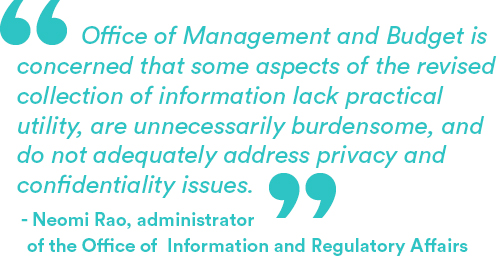On August 29th, the White House pressed pause on a rule requiring companies with 100 or more employees to share data with the government about how they pay employees by race and gender via EEO-1 reporting. The rule’s intended purpose? To reduce the gender wage gap.

WHAT WAS THE ISSUE?
Companies with more than 100 employees and federal contractors with at least 50 employees would have had to report detailed salary data to the Equal Employment Opportunity Commission (EEOC) on their annual EEO-1 report. Employers would have had to report W-2 wage information (specifically box 1) and total hours worked for all employees by race, ethnicity, and sex within 12 pay bands, for employees with wages from $19,000 to $208,000 and higher. The proposed rule would also have grouped workers into 10 categories, from service employees to managers to executives.
ethnicity, and sex within 12 pay bands, for employees with wages from $19,000 to $208,000 and higher. The proposed rule would also have grouped workers into 10 categories, from service employees to managers to executives.
The Office of Management and Budget (OMB) stopped the rule from taking effect to review further, asserting that asking employers to collect more comprehensive pay data would have put a strain on employers’ resources. Many also argued that comparing employees by pay oversimplifies how complicated the wage gap issue actually is.
WHEN DO I NEED TO FILE MY EEO-1 REPORT?

Previously, employers had to file their EEO-1 report by September 30th each year. However, the deadline to file was pushed back to March 31, 2018, under the proposed rule. That date is still valid, and employers should be ready to file their annual reports online by March 31st of next year.
WHO NEEDS TO FILE AN EEO-1 FORM?
Not all employers are required to file the annual report, only those who meet the following requirements:
- Employers with 100 or more employees
- Enterprise that employs 100 or more employees
- Federal contractor or subcontractor with 50 or more employees and contract worth $50,000 or more
WHAT INFORMATION DOES THE EEO-1 FORM COLLECT?
EEO annual reporting requires companies to collect employment data by race and ethnicity, gender, and job category. All of your full- and part-time employees must be included in the report, and employees in all 50 states and the District of Columbia. The information is private and cannot be made public. For this upcoming filing, employers should use payroll data from a payroll period in either October, November, or December of 2017.
TIPS FOR EMPLOYERS
Some believe the wage gap can be explained by differences in skills, experience, or preferences. Others disagree. Politics aside, the wage gap is a daily reality for most women, so be thoughtful in your approach to pay equality discussions. Consider evaluating your compensation structures for pay disparities and discriminatory pay practices. And remember that no solution is simple and no solution works for every employer. Other things you can do include:

- Make sure you are already in compliance with employment laws in case the EEOC cracks down on enforcement.
- Consider avoiding pay secrecy policies that allow employers to ask an applicant how much they currently make, and allow employees to discuss compensation openly.
- Make pay more transparent and publish pay rates and salary info when advertising jobs.
- Be aware of employment regulations before they become laws and advocate for your employees.
It’s not just gender discrimination you need to be thinking about – there are five federal statutes that ban discrimination in pay based on age, race, ethnicity, or disability: the Equal Pay Act (EPA), Title VII of the 1964 Civil Rights Act, Age Discrimination in Employment Act (ADEA), and the Americans with Disabilities Act (ADA); and Executive Order 11246 prohibits pay discrimination by federal contractors.
The smartest thing to do is keep up with what’s going on in the HR industry and political spheres that affect your business and your employees. Staying ahead of changes is half the battle.
